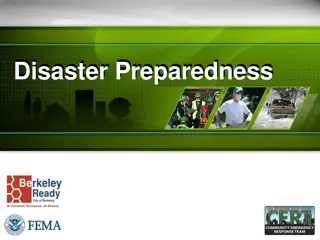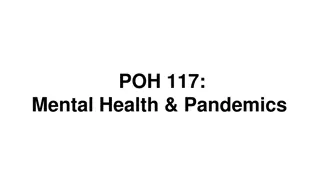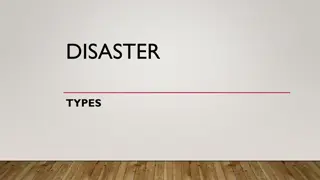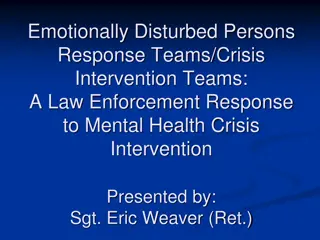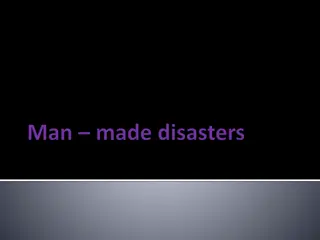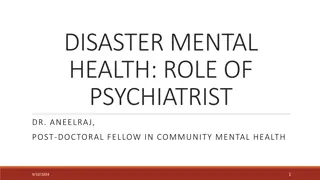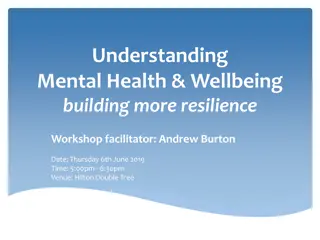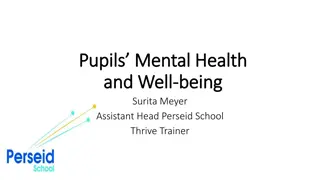Mental Health Preparedness in Disasters: Understanding and Response
This program aims to raise awareness about the mental health implications of disasters, familiarize individuals with common survivor reactions, and empower them to provide immediate assistance post-disaster. It emphasizes the importance of mental health services in disaster planning and response, showcasing examples and implications for public health.
Download Presentation

Please find below an Image/Link to download the presentation.
The content on the website is provided AS IS for your information and personal use only. It may not be sold, licensed, or shared on other websites without obtaining consent from the author. Download presentation by click this link. If you encounter any issues during the download, it is possible that the publisher has removed the file from their server.
E N D
Presentation Transcript
Introduction to Mental Health Preparedness Upper Cumberland Medical Reserve Corps Click this arrow to advance to the next screen 1
Part One INTRODUCTION TO DISASTERS AND NORMAL RESPONSES 2
This program IS intended to: Make you aware that there are mental health consequences to disasters Expose you to the common reactions of survivors to disasters Help you anticipate normal reactions of survivors Show you what you can do to assist survivors immediately following a disaster 3
This program is NOT intended to: Train you to assess, diagnose or treat individuals with post-traumatic stress disorder or other psychiatric illness resulting from disaster Address the long-term treatment or counseling needs of disaster survivors Prepare you for your own reactions to the disaster 4
Consequences of disasters Physical Destruction, injury, and, sometimes, death Emotional Various forms of stress are common 5
Need for disaster mental health services There are more mental health injuries than physical injuries. The mental health of a community before a disaster occurs will determine how resilient the community is after a disaster. Disaster mental health services are a vital component of planning and response. 6
Example of need for disaster mental health In 1995, a Japanese religious cult released sarin gas in a subway system in Tokyo. 12 died 5,500 sought medical care Most had no signs of exposure Many had anxiety 7
Implications for public health There is a potential for a high ratio of mental health casualties. Immediate mental health services may be delivered by non-mental health personnel. With specialized training, public health workers and volunteers can provide basic crisis intervention . 8
Definition of disaster A disaster is an occurrence such as Hurricane, tornado, flood, earthquake Explosion, hazardous material accident War, fire, famine or epidemic 9
Definition of disaster Disasters Cause human suffering Create a collective human need Require outside assistance to alleviate its effects 10
Types of traumatic events Natural disasters Technological disasters Man-made disasters Other interpersonal violence Sudden traumatic loss 75% of the US population will be exposed to some event in their lifetime that meets the stressor criteria for post-traumatic stress disorder (PTSD) 11
Defining traumatic stress Traumatic stress refers to the emotional, cognitive, behavioral and psychological experiences of individuals who are exposed to, or who witness, events that overwhelm their coping and problem-solving abilities. Lerner & Shelton, 2001 12
Defining traumatic stress Traumatic stress disables people, causes disease, precipitates mental disorders, leads to substance abuse, and destroys relationships and families. Additionally, traumatic stress may lead to post-traumatic stress disorder (PTSD). Lerner & Shelton, 2001 13
Factors influencing response to traumatic events Multiple traumatic exposures History of mental illness Low socio- economic status Intensity and duration of exposure Gender Age Pre-trauma factors 14
Typical disaster response patterns Cognitive (pertaining to the mental processes of perception, memory, judgment ,and reasoning) Distractibility Duration, sequence, distortion Declining school/work performance Recurrent intrusive recollections Flashbacks, nightmares 15
Typical disaster response patterns Behavioral Clinging, isolation Thrill-seeking behaviors Re-enactments of trauma Increased substance abuse Hyper-vigilance Elevated startle reflex 16
Typical disaster response patterns Physical Shock symptoms Insomnia Loss of appetite Headaches Muscle weakness Elevated vital signs 17
Typical disaster response patterns Affective (relating to mood, feelings and attitudes) Depression, anxiety Numbness Constricted affect (mild restriction in the range or intensity of display of feelings) Guilt, shame, fear Intolerance of fear response 18
Psychological reactions to disasters Source: www.peakoilblues.org681 19
Psychological reactions to disasters First phases Threat time before impact; potential hazards or threats for the community Warning communities receiving notice of disaster; ranges from no advance notice to weeks before Impact the disaster is occurring; actual onset 20
Psychological reactions to disasters Next phases Heroic immediately after a disaster; intense effort to rescue others; people watch out for and protect others Honeymoon weeks or months after a disaster; help from volunteers and government; survivors experience short-lived sense of optimism Inventory external resources become available, but survivors recognize that disaster sources are limited; people are physically and emotionally exhausted and discouraged 21
Psychological reactions to disasters Final phases Disillusionment survivors feel abandoned or resentful; disaster assistance agencies and volunteer groups pull out; resources seen as poorly allocated Reconstruction/Recovery months to years after the disaster; individuals and communities rebuild physical property and recover emotional well-being 22
Psychological reactions seen among disaster survivors Normal psychosocial responses Short-duration distress or dysfunction Severe distress or dysfunction 23
Resistance, resilience and recovery Resistance defend against manifestations of distress, impairment or dysfunction Resilience rebound rapidly and effectively from psychological distress Recovery regain the ability to function adaptively in the wake of distress, impairment or dysfunction 24
Healthy coping skills Ability to orient oneself rapidly Planning and execution of decisive action Appropriate use of assistance resources Tolerance of uncertainty without resorting to impulsive action Appropriate expression of painful emotions 25
Unhealthy coping skills Excessive denial and avoidance Impulsive behavior Over-dependence Inability to evoke caring feelings from others Emotional suppression Substance abuse 26
Cultural factors influence disaster reactions and coping skills National origin Customs and traditions Length of residency Language Age and generation Gender Religious and political beliefs Perceptions of family and community Health, well-being, disability, physical ability or limitations Socio-economic status Education level Geographic location 27
Cultural competence Cultural competence is a set of values, behaviors, attitudes and practices that enable people to: Work effectively across cultures Respect beliefs, languages and behaviors of individuals and families receiving services and of staff providing services 28
Normal stress reactions to abnormal situations Cognitive Behavioral Physical Emotional Spiritual 29
Problematic stress responses to disasters Debilitating anxiety Severe dissociation Severe intrusive re-experiencing Extreme avoidance Severe depression Problematic substance abuse Psychotic symptoms 30
Four syndromes commonly seen post-disaster Generalized anxiety disorder (GAD) Post-traumatic stress disorder (PTSD) Major depression Alcohol abuse 31
Alcohol abuse Not uncommon to see survivors of disasters use self-medication as a coping mechanism Self-medication may be thought of as the self-prescribed use of any psychoactive substance in order to reduce distress Most common substance used in self- medication is alcohol, due to ease of accessibility 32
Self-medication substances Other substances for self-medication may include Caffeine Over-the-counter medications Illicit drugs Increased use of medications that have already been prescribed 33
Understanding terrorism The goal of terrorism is the creation of extreme fear, destroying the individual and communal sense of safety and security 34
Goal of terrorism Terrorist attacks are intended to cause psychological, social and economic disruption, not simply to hurt or kill those in close proximity to the attack Terrorism is a strategic weapon, not a tactical weapon, in asymmetrical warfare 35
Psychodynamics of CBNR disasters CBNR chemical, biological, nuclear, radiological Subgroup of technological disasters often referred to as silent disasters Have the added dimension of future orientation , such as delayed medical illness, risk of birth defects, and other forms of genetic transmission 36
Terror-producing aspects of CBNR events Potential for high number of casualties Limited availability of treatments Uncertainty about effectiveness of treatments Contagion Dispersion of biological casualties Silent disasters odorless, invisible, quiet 37
Mental health implications of CBNR disasters Chronic anxiety Depression Alienation, mistrust, paranoia Somatic reactions (what effect the agent will have on your body) The possibility of disease to the individual or their family poses an ongoing and chronic stressor. 38
Mental health preparedness concepts - summary There are physical and psychological consequences. Stressors can range from natural disasters to terrorist events. There are normal stress reactions to these stressors. There are also problematic reactions to these stressors. 39
Mental health preparedness concepts - conclusion Be aware of physical and psychological consequences. Prepare yourself by anticipating normal stress reactions and natural resilience You can make a difference! 40
Introduction to Disasters and Normal Responses Review 41
Which of the following is not generally not a consequence of disasters? Physical Nutritional Emotional 42
Which of the following is not generally not a consequence of disasters? Nutritional Good job! Click to continue Good job! Click to continue 43
Which of the following is not generally not a consequence of disasters? Physical Try again Try again 44
Which of the following is not generally not a consequence of disasters? Emotional Try again Try again 45
How much of the US population will be exposed to some event in their lifetime that meets the stressor criteria for post-traumatic stress disorder (PTSD) 25% 50% 75% 46
How much of the US population will be exposed to some event in their lifetime that meets the stressor criteria for post-traumatic stress disorder (PTSD) Good job! Click to continue Good job! Click to continue 75% 47
How much of the US population will be exposed to some event in their lifetime that meets the stressor criteria for post-traumatic stress disorder (PTSD) 25% Try again Try again 48
How much of the US population will be exposed to some event in their lifetime that meets the stressor criteria for post-traumatic stress disorder (PTSD) Try again 50% Try again 49
Which typical disaster response pertains to the mental processes of perception, memory, judgment and reasoning? Cognitive Behavioral Affective 50



